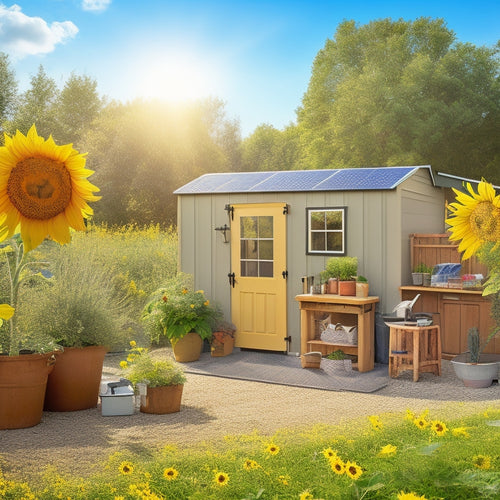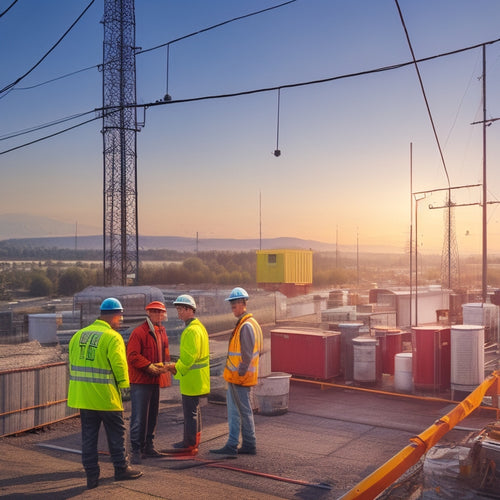
Is This the Most Efficient Eco-Friendly Power Generator
Share
Determining the most effective eco-friendly power generator depends on various factors, including technology and application. Advances in solar panels and wind turbines have greatly increased efficiency. For example, bifacial solar panels and larger wind turbine blades maximize energy capture. Incorporating smart sensors and state-of-the-art materials enhances performance, while innovative designs facilitate maintenance. Additionally, eco-friendly generators contribute to cost savings through lower energy expenses and reduced carbon footprints. By evaluating your specific energy needs and available resources, you can identify the best solution. If you're curious about specific technologies and their impacts, there's plenty more to investigate.
At a Glance
- The most efficient eco-friendly power generators utilize advanced materials and design innovations to maximize energy output and minimize waste.
- Innovations in energy conversion mechanisms enhance efficiency by integrating real-time performance monitoring and modular designs for maintenance.
- Renewable energy sources like solar and wind, equipped with cutting-edge technologies, significantly reduce energy expenses and carbon footprints.
- Long-term investment benefits include lower operating costs and predictable energy expenses, making eco-friendly generators financially advantageous over time.
- Conducting a power assessment ensures that the generator meets current and future energy needs, enhancing overall efficiency and effectiveness.
Sustainable Energy Source Options
When exploring sustainable energy source options, you'll find that solar energy innovations and wind power advances are at the forefront of the eco-friendly movement.
These technologies not only enhance efficiency but also reduce reliance on fossil fuels, making them critical in the shift to greener energy solutions.
Off-grid solar systems enable energy independence and enable individuals to take control of their energy needs.
Solar Energy Innovations
Solar energy innovations have altered the terrain of sustainable energy sources, offering a plethora of state-of-the-art solutions that not only improve efficiency but also reduce environmental impact.
You'll find that advancements in solar panel technology, such as bifacial panels and transparent solar cells, are at the forefront of this change. These innovations capture sunlight from multiple angles and even convert windows into energy-generating surfaces, maximizing the potential of every square foot.
As you investigate renewable energy trends, consider how energy storage solutions, like lithium-ion and flow batteries, are becoming essential. They guarantee that solar energy isn't only generated but also stored and employed efficiently, addressing the intermittency issues often associated with solar power.
Moreover, smart solar inverters are revolutionizing how energy is managed, allowing for real-time monitoring and optimization of energy production.
This means you can adapt your energy consumption patterns to leverage solar power when it's most available.
Wind Power Advances
As advancements in solar energy pave the way for a more sustainable future, wind power technologies are also making extraordinary progress, enhancing the viability of this renewable energy source.
You'll find that recent innovations in turbine technology are key to optimizing energy production. Modern turbines are designed to capture wind energy more efficiently, thanks to larger rotor diameters and advanced blade materials that reduce drag and increase lift. This means you can utilize more power with fewer turbines, maximizing energy output.
Offshore wind farms are becoming increasingly popular, taking advantage of stronger and more consistent winds over the ocean. These installations can generate substantial amounts of electricity, contributing to energy independence and reducing reliance on fossil fuels.
With floating turbine technology, you can now access deeper waters, where winds are even more powerful, making offshore projects more feasible and effective.
The combination of these advancements positions wind power as a formidable contender in the pursuit of sustainable energy solutions.
Cost Savings Over Time
Investing in an eco-friendly power generator not only supports sustainability but also offers significant long-term financial benefits.
By utilizing renewable energy, such as through roof-mounted solar panels, you can drastically reduce your monthly energy expenses, leading to substantial savings over time.
This innovative approach alters your energy consumption into a cost-effective strategy that pays off well into the future.
Long-Term Investment Benefits
When considering the shift to an eco-friendly power generator, you'll quickly recognize that your initial investment pays dividends over time. The financial incentives often available, such as tax credits or rebates, greatly enhance your investment returns, making this shift not just environmentally responsible but also economically savvy.
Here's a breakdown of potential long-term benefits:
| Year | Initial Investment | Cumulative Savings |
|---|---|---|
| 1 | $10,000 | $1,500 |
| 3 | $10,000 | $4,500 |
| 5 | $10,000 | $8,000 |
As you can see, the savings compound over the years, allowing you to recoup your investment quickly. In addition, the eco-friendly generator operates with lower maintenance costs and longer lifespans compared to traditional generators. Your decision to adopt this technology not only frees you from volatile energy prices but also aligns with a sustainable lifestyle.
Ultimately, embracing an eco-friendly power generator can lead to substantial financial advantages, ensuring that your investment pays off handsomely in the long run.
Reduced Energy Expenses
Over time, opting for an eco-friendly power generator greatly reduces your energy expenses. By utilizing renewable resources, you can markedly lower your utility bills.
Conducting energy audits allows you to identify inefficiencies in your current system, enabling you to optimize energy usage. This knowledge is essential for informed budget planning, as it highlights areas where you can save.
When you invest in an eco-friendly generator, you're not just reducing your carbon footprint; you're also enhancing your financial freedom. These generators often come with lower operating costs compared to traditional fossil-fuel systems.
Their efficiency translates to less energy consumption, which means you keep more money in your pocket.
Furthermore, as energy prices fluctuate, eco-friendly generators protect you from the volatility of the market. You gain stability in your energy expenses, making it easier to plan your finances over the long term.
Imagine the peace of mind knowing that your energy costs are predictable and manageable.
Innovative Design for Efficiency
In designing an eco-friendly power generator, you'll find that state-of-the-art materials play an essential role in enhancing performance. These materials not only reduce weight but also improve durability, allowing for a more streamlined energy conversion process.
Additionally, advancements in battery technology contribute to the overall efficiency of these systems, as innovative cost reduction methods and increased energy density are continually being developed.
As you investigate these innovations, consider how they collectively drive efficiency and sustainability in energy production.
Cutting-Edge Materials Used
Utilizing advanced composites and nanomaterials, today's eco-friendly power generators achieve unparalleled levels of efficiency and sustainability. These state-of-the-art materials, such as biodegradable composites, are essential in reducing the environmental footprint of energy production.
By integrating these materials, generators not only minimize waste but also guarantee a longer lifespan and improved performance.
Thermoelectric materials, known for their ability to convert temperature differences into electrical energy, play a significant role in enhancing power generation efficiency. By incorporating high-performance thermoelectric materials, you can utilize waste heat from various processes, changing it into usable energy.
This innovative approach allows you to maximize energy output while minimizing resource consumption.
Moreover, the lightweight and sturdy nature of these advanced materials facilitates more versatile designs, enabling you to deploy power generators in a variety of environments.
The use of nanomaterials enhances thermal conductivity and electrical performance, pushing the boundaries of what's possible in eco-friendly energy solutions.
Streamlined Energy Conversion Process
A streamlined energy conversion process is essential for maximizing the efficiency of eco-friendly power generators. By focusing on process enhancement, you can greatly improve the way energy is captured and employed, ultimately reducing waste and improving output. Innovative designs exploit advanced algorithms and materials to create a more effective energy conversion mechanism.
For instance, incorporating smart sensors can actively monitor performance, allowing real-time adjustments that fine-tune the conversion process. This adaptability enables you to respond to varying environmental conditions, ensuring peak energy capture regardless of fluctuations.
Moreover, employing a modular design simplifies maintenance and upgrades, further enhancing efficiency. Each component in the energy conversion chain must work harmoniously, minimizing energy loss and maximizing output.
By integrating renewable sources such as solar or wind with advanced storage solutions, you can create a more resilient energy system that meets your needs while respecting nature.
In essence, embracing a streamlined energy conversion process isn't just about efficiency; it's about the freedom to capture clean energy effectively. By prioritizing innovation and enhancement, you can contribute to a sustainable future while enjoying the benefits of reliable, eco-friendly power.
Assessing Energy Output Requirements
To effectively assess your energy output requirements, you first need to determine your power needs based on your specific applications.
This includes understanding how energy storage systems like battery backup systems can support critical farm operations.
Next, analyze the available energy sources that can meet those demands sustainably.
Determine Power Needs
Before initiating the expedition to select an eco-friendly power generator, you need to accurately assess your energy output requirements. Start by conducting a thorough power assessment of your household or project.
List all appliances, devices, and systems you intend to power, noting their wattage and energy consumption rates. This initial inventory will help you identify your total energy needs.
Next, consider factors such as peak usage times and duration of energy consumption. Are you planning to run high-demand equipment simultaneously, or will you stagger usage? This analysis is essential for understanding your maximum load requirements.
Additionally, account for any future power needs. If you plan to expand your energy consumption, incorporating potential growth into your assessment guarantees you won't outgrow your generator's capacity too soon.
Analyze Energy Sources
Having established your power needs, the next step is to analyze the energy sources available for your eco-friendly generator.
You'll want to conduct a thorough renewable resource assessment to determine which options align best with your requirements. Start by evaluating solar, wind, hydro, and biomass sources. Each has unique characteristics, energy outputs, and capital costs.
Consider the geographical and climatic factors that affect each resource's efficiency. For instance, if you live in a sunny area, solar power may be your go-to option, while wind could be more effective in coastal regions.
Lower Carbon Footprint Impact
When you consider the reduced emissions benefits of eco-friendly power generators, you're looking at a significant shift in your energy consumption patterns.
These systems not only lower greenhouse gas output but also enhance overall air quality, positively impacting health and the environment.
Reduced Emissions Benefits
The shift to eco-friendly power generators greatly lowers carbon emissions, directly benefiting both the environment and public health. By adopting innovative technologies, you're contributing to significant carbon reduction.
These generators typically employ renewable energy sources such as solar, wind, and hydro, which drastically minimize reliance on fossil fuels. This change enhances emission control, leading to cleaner air and reduced greenhouse gas effects.
You mightn't realize it, but each decision to use eco-friendly generators translates into tangible environmental benefits. As you capture solar or wind energy, the emissions associated with traditional power generation diminish, resulting in a healthier atmosphere.
This reduction in pollutants helps combat climate change and encourages a sustainable energy environment.
Moreover, eco-friendly power generators often feature advanced systems designed for efficiency, further lowering emissions. By investing in these technologies, you're not just powering your home or business; you're actively participating in a movement towards a more liberated, sustainable future.
In this way, the benefits extend beyond immediate energy savings, providing long-term advantages for both society and the planet.
Embracing eco-friendly power generation is a powerful step toward achieving a cleaner, freer world.
Frequently Asked Questions
How Does This Generator Compare to Traditional Energy Sources?
You'll find this generator often outperforms traditional sources in cost efficiency and energy output. Its innovative design maximizes performance while minimizing environmental impact, granting you more freedom to utilize sustainable energy without compromising power needs.
What Maintenance Is Required for Optimal Performance?
To guarantee ideal usage, you should regularly check fuel levels, clean filters, and inspect connections. Following these maintenance tips enhances efficiency and extends lifespan, allowing you to utilize energy freely and sustainably.
Can It Be Used in Remote Locations?
Yes, you can definitely use it in remote locations. Its ability to utilize remote energy makes it a viable choice for sustainable solutions, granting you the freedom to access power wherever you need it most.
What Are the Warranty Terms for This Generator?
When you invest in a generator, understanding its warranty terms is essential. Warranty coverage typically aligns with the generator's lifespan, ensuring you're protected against defects while enjoying the freedom of uninterrupted power in remote locations.
Are There Any Government Incentives for Using This Technology?
Yes, you can benefit from incentive programs and tax credits that encourage the adoption of innovative technologies. Research your local and federal options to maximize savings while contributing to a sustainable energy future.
Explore More
To sum up, when you consider efficiency, sustainability, and cost-effectiveness, this eco-friendly power generator stands out. It's not just about capturing energy; it's about altering how we think about power. By reducing our carbon footprint and maximizing output, you're not only investing in a cleaner future but also securing long-term savings. Isn't it time to accept innovation that aligns with our planet's needs? The choice is clear: this generator could be the key to a greener tomorrow.
Related Posts
-

Is This the Future of Alternative Energy Systems
Yes, alternative energy systems are shaping the future of energy. Innovations in solar and wind technologies are driv...
-

Building an Emergency Backup Solar Power System in 5 Essential Steps
Building an emergency backup solar power system involves five key steps. First, assess your daily energy needs to ide...
-

Smart Grid Technology Implementation Challenges
You'll encounter several challenges when implementing smart grid technology, particularly in cost management, scalabi...


